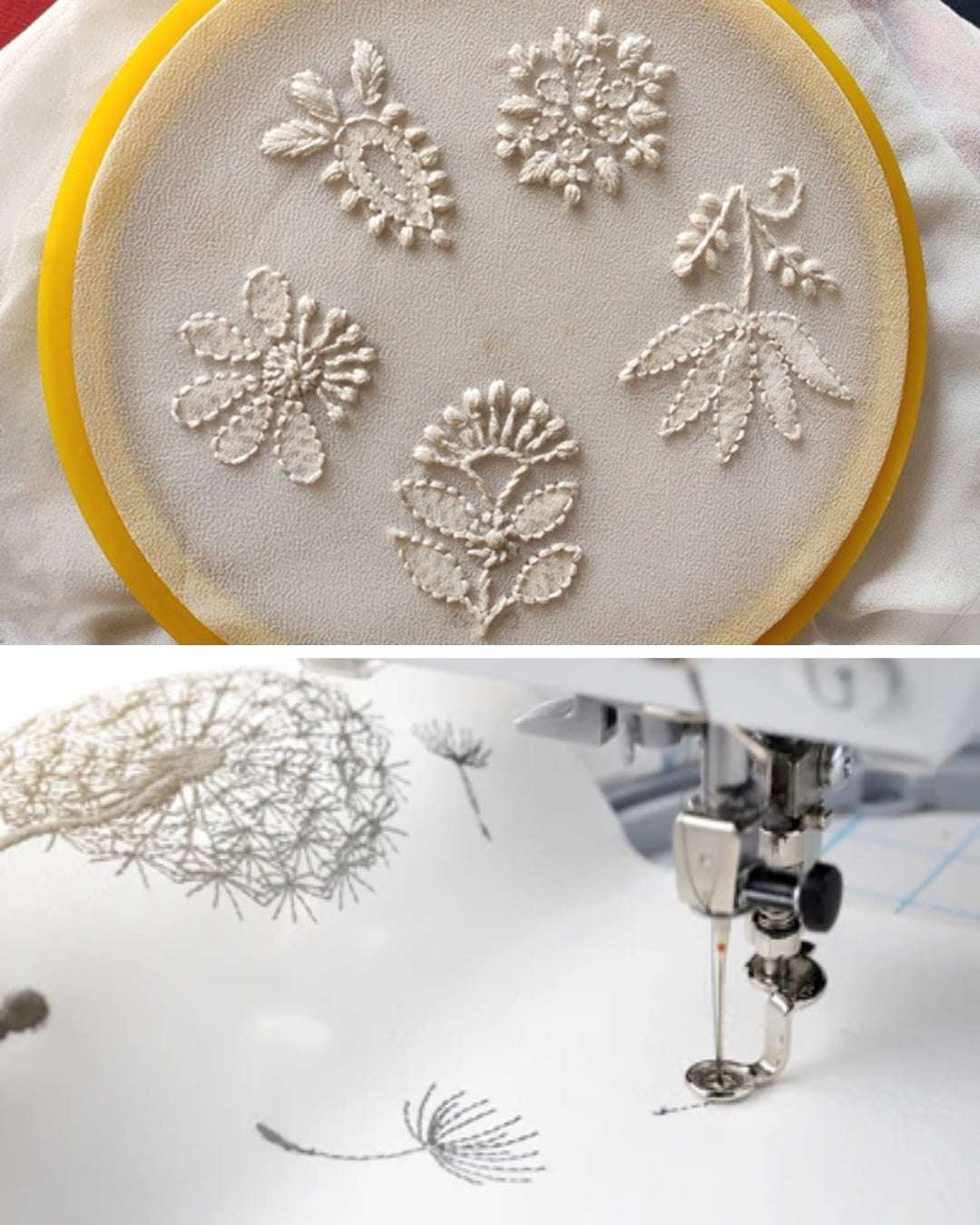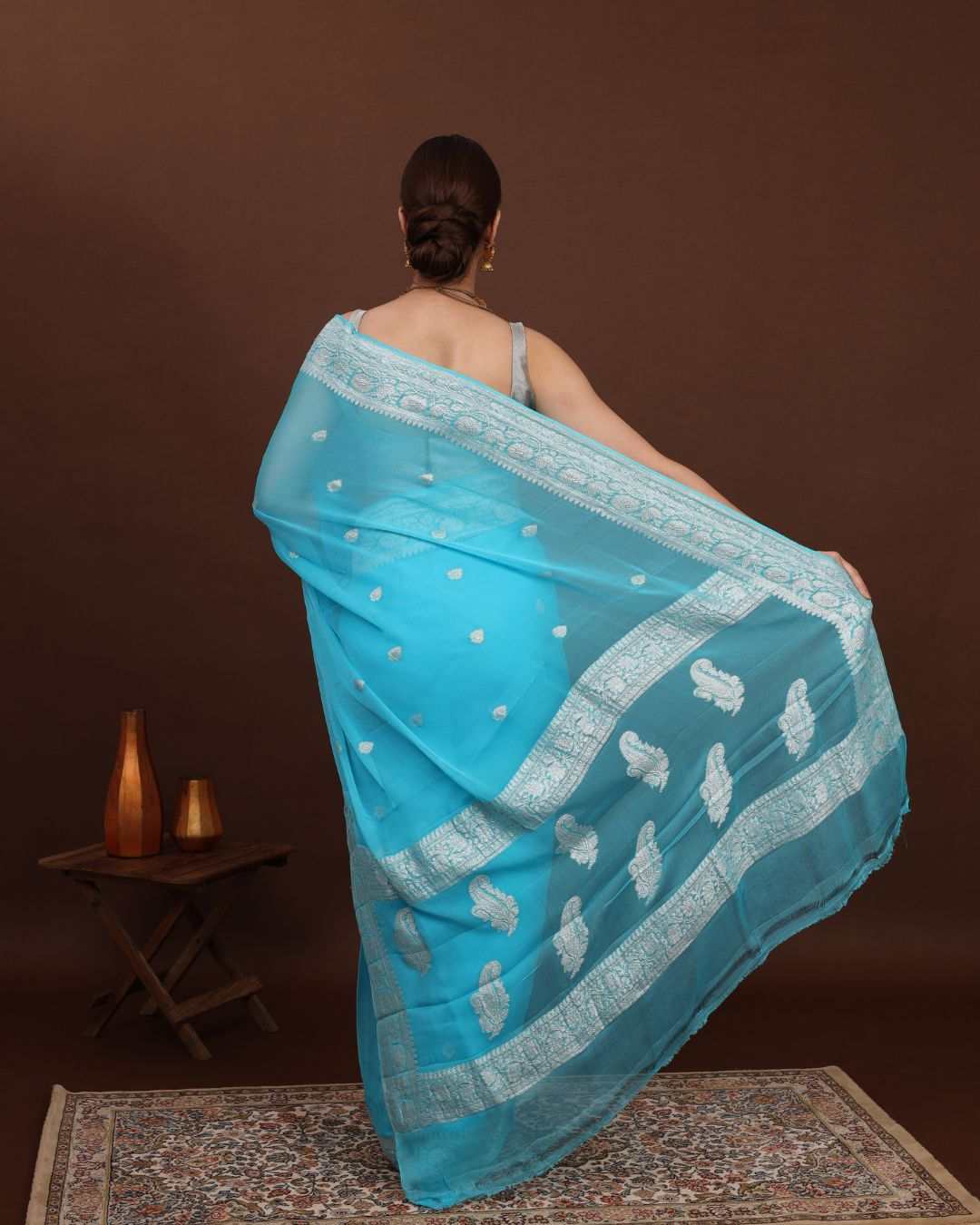Banarasi Silk: A Symbol of Indian Identity
Banarasi silk, originating from Varanasi, is a centuries-old textile known for its luxurious feel and detailed zari work. It plays a central role in Indian weddings, religious events, and festivals, symbolising celebration and heritage. Brides in regions like Bengal and Punjab often wear red Banarasi sarees, while the fabric is also a favourite for temple rituals and classical dance performances.
Artisans, using techniques passed down generations, create these sarees with precision, often incorporating sacred symbols. The rise of eco-friendly methods, like natural dyes, ensures Banarasi silk aligns with modern values. Brands like House of AKS support weavers, offering sarees priced between ₹4,174 and ₹22,777, blending legacy with contemporary needs. Despite challenges like cost and labour intensity, Banarasi silk remains a treasured part of India’s shared heritage.
1. Banarasi Silk in Regional Traditions
Historical Roots Across Indian States
Banarasi silk traces its origins to the ancient city of Varanasi, where its luxurious texture and intricate designs have been cherished for generations. Over the centuries, communities across India have embraced this textile, with local artisans weaving their own traditions into its timeless charm. These deep historical roots have cemented Banarasi silk's place in India's rich textile heritage.
Cultural Significance in Regional Customs
Known for its soft texture and elaborate gold and silver zari work, Banarasi silk holds a special place in Indian culture. It is more than just fabric; it’s a symbol of celebration, prosperity, and timeless beauty. Whether it’s a wedding, religious ceremony, or festive gathering, Banarasi silk is often the attire of choice, reflecting the grandeur and artistry of Indian traditions.
Regional Weaving Adaptations
What makes Banarasi silk even more fascinating is how local weavers across India have incorporated their own regional motifs into its classic designs. These creative interpretations not only highlight the textile’s adaptability but also honour the artistic diversity of India. Such efforts ensure that Banarasi silk remains relevant while celebrating the unique touch of every region.
Sustainability and Traditional Practices
In recent years, artisans have turned to sustainable practices, such as using natural dyes and eco-friendly weaving methods, to keep the Banarasi silk tradition alive in an environmentally conscious world. These efforts not only preserve the age-old craftsmanship but also align with modern values, ensuring this iconic fabric continues to thrive while respecting its cultural and ecological heritage.
2. Banarasi Silk in Wedding and Religious Events
Banarasi silk holds a cherished place in Indian ceremonies, blending tradition with artistry to symbolise cultural identity and devotion.
Banarasi Silk in Hindu Weddings
Banarasi silk sarees have been an integral part of Indian weddings since the Mughal era, where Persian-inspired motifs met Indian craftsmanship. These sarees, especially adorned with intricate gold zari work, represent prosperity, fertility, and divine blessings in Hindu matrimonial rituals.
In northern and eastern India, brides often wear red Banarasi silk sarees during the main ceremony. The colour red signifies purity, love, and new beginnings, making it a meaningful choice for many Bengali and Punjabi brides. Beyond their aesthetic appeal, these sarees carry the weight of tradition, often passed down through generations, preserving familial and cultural heritage.
Religious Ceremonies and Festivals
Banarasi silk also plays a vital role in religious events and festivals. During Diwali and Durga Puja, many devotees wear Banarasi silk garments to temple rituals, as the fabric’s natural sheen enhances the sanctity of worship and reflects devotion.
In South India, the sarees are a preferred choice for special pujas and festivals, often adorned with traditional motifs. Classical dancers performing Bharatanatyam frequently wear Banarasi silk sarees, as the fabric’s elegant drape adds to the visual splendour of the performance.
Craftsmanship Behind Ceremonial Banarasi Silk
The creation of ceremonial Banarasi silk sarees is a labour of love, involving techniques perfected over centuries. Master weavers use intricate methods to ensure every design element is visible from all angles, with some sarees taking months to complete depending on the complexity of the patterns.
For religious occasions, artisans often incorporate sacred symbols like Om, lotus petals, and geometric designs into the fabric. These details not only highlight the artisan’s expertise but also ensure each piece resonates with the cultural and spiritual significance that defines Banarasi silk.
A Shift Towards Eco-Friendly Practices
In recent years, a growing number of artisans have adopted sustainable practices in Banarasi silk production. By using natural dyes and eco-friendly materials, they cater to the increasing environmental awareness among Indian families. This shift allows communities to honour age-old traditions while embracing a more environmentally conscious approach to crafting these ceremonial masterpieces.
sbb-itb-380d000
3. House of AKS Banarasi Silk Collection

House of AKS brings Banarasi silk to life, blending its deep-rooted legacy with contemporary elegance. Known for its dedication to India's textile traditions, the brand goes beyond commerce, embracing Banarasi silk as a vital piece of Indian culture. Each collection reflects the artistry and ceremonial significance tied to this timeless fabric.
Preserving Traditional Craftsmanship
At the heart of House of AKS lies a commitment to preserving the intricate art of Banarasi weaving. Crafted in Varanasi by master artisans, these sarees are the result of centuries-old techniques passed down through generations. Every piece carries the essence of this craftsmanship, ensuring authenticity and a personal touch.
The Banarasi silk collection showcases a variety of handwoven sarees, priced between ₹4,174 and ₹22,777. From tissue silk designs to Jamdani weaves, these sarees are perfect for weddings and festive occasions. The pricing reflects the labour-intensive process, with some designs requiring months of meticulous effort by skilled weavers.
Artisan Partnerships and Fair Practices
House of AKS works closely with Varanasi weavers, ensuring fair wages and supporting traditional weaving methods. By fostering these partnerships, the brand preserves the authenticity of Banarasi silk while uplifting the artisans behind its creation.
The sarees are produced in small batches, making each collection limited-edition. This exclusivity not only honours the time and skill involved in handweaving but also enhances the cultural and artistic value of each piece. By avoiding mass production, the brand ensures that the quality and heritage of Banarasi silk remain uncompromised.
Sustainable Production Methods
Sustainability is a core principle for House of AKS. Their Banarasi silk sarees are crafted using natural fabrics and designed to transcend fleeting trends. This philosophy encourages customers to see these sarees as lasting investments rather than disposable fashion.
In line with Indian traditions, these sarees are created to be passed down through generations, becoming cherished family heirlooms. By focusing on durability and timeless appeal, House of AKS not only honours the heritage of Banarasi silk but also ensures its place as a cultural treasure for years to come.
Themed Collections and Cultural Narratives
The brand curates themed collections like 'Heer', 'Riwaaz', and 'Chaand', each celebrating India's identity through distinctive designs and storytelling. These collections are released on specific schedules, building anticipation and ensuring that every piece feels special.
This approach reinforces the idea of Banarasi silk as more than just clothing - it’s a symbol of craftsmanship and heritage to be cherished. By combining traditional artistry with thoughtful presentation, House of AKS keeps Banarasi silk alive as a vibrant part of Indian culture and identity.
Pros and Cons
Banarasi silk holds a special place in Indian culture, celebrated for its rich heritage and its role in weddings, festivals, and other significant occasions. The intricate craftsmanship and deep-rooted tradition behind each piece make it a symbol of timeless elegance. However, incorporating authentic, hand-woven Banarasi silk into everyday wardrobes can be a challenge. The process of creating these exquisite fabrics is labour-intensive and expensive, which often makes them less practical for daily use. While cherished for its cultural significance, these factors can make it less accessible for regular wear.
Conclusion
Banarasi silk is more than just a fabric - it's a thread that ties together India's diverse traditions and cultural richness. From the grandeur of North Indian weddings to the colourful celebrations of festivals across communities, this fabric has stood the test of time, adapting to changing eras while maintaining its charm and significance.
In recent years, Banarasi silk has found new expressions, blending traditional artistry with modern sensibilities. This evolution shows how deeply rooted cultural treasures can adapt to contemporary demands without losing their soul. It’s a seamless connection between heritage and today’s style preferences.
What sets Banarasi silk apart is its unique position as both a cherished tradition and a thriving craft. This dual identity ensures that it remains a living, breathing part of India’s cultural landscape - not just a relic from the past.
The fabric’s journey from being a symbol of elite luxury to becoming an accessible yet elegant choice reflects India’s own blend of tradition and modernity. Whether it’s worn in its classic form or reimagined for modern wardrobes, Banarasi silk continues to tell a story of unity and shared heritage.
While challenges like labour-intensive production and higher costs persist, the cultural importance of Banarasi silk remains undeniable. Brands such as House of AKS are playing a vital role in keeping this tradition alive. Their handcrafted collections not only offer authentic pieces but also support artisan communities, proving that traditional craftsmanship and sustainable practices can thrive together in today’s world.
Ultimately, Banarasi silk embodies the richness of India’s legacy. Its greatest strength lies in its ability to connect every wearer to a shared cultural heritage - a heritage that belongs to all Indians. This is what makes Banarasi silk a timeless symbol of Indian identity.
FAQs
How does Banarasi silk stay relevant in today's fashion while honouring its traditional heritage?
Banarasi silk holds its place in modern fashion by beautifully merging age-old craftsmanship with today’s design trends. Artisans and designers are breathing new life into this iconic fabric, introducing updated cuts, fresh colour palettes, and contemporary patterns - all while honouring its deep-rooted legacy.
Even with these modern touches, the fabric's detailed weaving, timeless motifs, and cultural significance remain untouched. This harmony of tradition and innovation keeps Banarasi silk a beloved emblem of Indian heritage, admired across eras and styles.
What are the sustainable practices used in Banarasi silk production, and how do they enhance its quality and cultural significance?
Sustainable practices in the production of Banarasi silk focus on using natural dyes derived from plants and minerals, promoting organic silk farming that eliminates harmful chemicals, and relying on handloom weaving techniques that minimise electricity use and reduce pollution. These eco-conscious methods not only protect the environment but also honour the traditional artistry that Banarasi silk is renowned for.
Such environmentally friendly approaches improve the silk's quality by ensuring it remains durable and free from chemicals. At the same time, they help preserve the cultural legacy of Banarasi silk, a timeless representation of India's rich textile heritage.
How does House of AKS ensure the authenticity and quality of their Banarasi silk sarees while supporting artisans?
House of AKS takes pride in offering genuine Banarasi silk sarees by collaborating directly with skilled artisans who specialise in traditional handweaving techniques. Their approach emphasises fair practices and close partnerships with these craftsmen, ensuring that the intricate art of Banarasi weaving continues to thrive.
By championing the work of these artisans and honouring their expertise, House of AKS preserves the legacy of this centuries-old craft. Each saree they create reflects the richness of India's textile traditions, showcasing the timeless beauty and unmatched quality of Banarasi silk.




